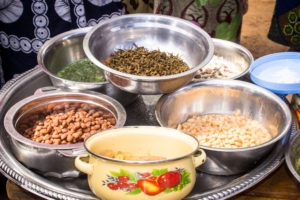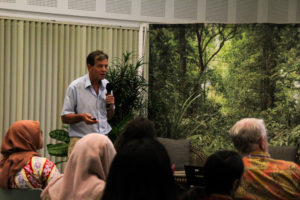The global narrative on food security and nutrition is not new: 1 billion people go hungry because they do not get enough food to eat; 3 billion people are malnourished because they lack nutritious food; 2.5 billion people are overweight often because they consume too many empty calories.
International scientists are trying to find innovative solutions to tackle these layers of food insecurity, known as “the triple burden of malnutrition.”
The best approach to balancing nutritious food supply and demand means reevaluating the way food is produced and distributed and by addressing environmental challenges, including climate change and poor land management strategies.
Watch: Enhancing food system resilience
“We need better and more sustainable food systems and within that, to determine what role forests, trees and agroforestry play,” said Vincent Gitz, director of the CGIAR Research Program on Forests, Trees and Agroforestry (FTA), who moderated a recent discussion on enhancing food system resilience at the Center for International Forestry Research (CIFOR).
Solutions could be found by moving away from production-centric notions, which focus on increasing crop yields through agricultural intensification, toward transformation of food production systems, said keynote speaker John Ingram, leader of the Food Research Programme in the Environmental Change Institute at the University of Oxford, which coorganized the discussion with FTA.
The various stages of food production – including storage, packaging, sales, consumption and disposal – result in disparate socioeconomic and environmental outcomes, Ingram said.
“We’re trying to establish how to manage the tradeoffs between the two by exploiting potential synergies with intervention,” he added, listing various environmental food-related challenges.
By charting projected increases in population and wealth, as part of his research, Ingram extrapolated future calorie consumption, demonstrating that food system challenges are interconnected.

“The environmental consequences of meeting this demand under current food system practices and consumption trends are dire,” he said. A linear projection over the next 10 years based on current trends shows that more than half the population would be overweight.
“The challenge is to achieve food security for a growing, wealthier, urbanizing population while minimizing further environmental degradation against a background of stresses and shocks: natural resource depletion; many stagnating rural economies, changing climate and extreme weather, and social and cultural changes,” he added.
Read also: John Ingram presents enhancing food system resilience
The aim is to develop resilience through a healthy food system so that these food system stresses can be addressed, while also laying the groundwork to tackle unpredictable events at the same time. Adaptation through reorganization of the food system is key, Ingram said.
“There was a notion we wanted sustainable diets,” he said. “What we actually want is sustainable systems delivering healthy diets.”
The challenge is to ramp down and ramp up simultaneously, he said. On the one side, the human health agenda must be addressed, which involves the World Health Organization (WHO) and UN Environment. On the other, the development agenda must work toward providing food security and nutrition for those who do not yet have it, which involves the CGIAR agricultural research partnership and the UN Food and Agriculture Organization (FAO).
“The important thing is looking for this word ‘synergy’; it really should be possible to get these two agendas hand-in-hand, and one of the best ways to do it is to include business more overtly in this equation,” Ingram said. “It’s the agents of change, the food system actors that we need to engage. And that means everybody.”

FORESTS AT FOREFRONT
Forests have a vital role to play in restructuring food production systems and in maintaining environmental equilibrium. More than a billion people rely on forests and forest resources, which provide an important safety net at times of food and income insecurity, said Terry Sunderland, senior associate with CIFOR and a professor at Canada’s University of British Columbia.
It is paramount to ensure that the contribution of forests and trees is optimized across the four pillars of food security and nutrition – availability, access, utilization and stability – in a context of climate change and increasing demands on land for wood, food energy and ecosystem services, Sunderland said.
The international community must recognize that research has shown that people living closer to forests have better diets, and must integrate forests into food policies, he added.
World Agroforestry (ICRAF), for instance, has developed a portfolio to recommend ecologically suitable combinations of food trees and crops to provide year-round harvests. The project aimed to boost fruit and vegetable consumption, which is often consumed at a rate far lower than recommended by WHO, said ICRAF scientist Stepha McMullen.
“Without this documentation, it could mean that certain crops are overlooked, particularly in agriculture and nutrition planning projects and policies,” she said.
Indigenous and underutilized food tree and crop species are key in local food systems because they are often more adapted to the landscape and therefore more resilient in the face of climate change.
The mainstreaming of these foods into wider use is necessary to ensure communities are harnessing their total value, McMullen said.
LOCAL TO GLOBAL
Policies focused on sustainable intensification of agriculture can have a negative impact on the quality of diets of people living in those producing landscapes, said Amy Ickowitz, team leader of Sustainable Landscapes and Food at CIFOR.
If fewer types of food are grown in a landscape, there are fewer types available for consumption, she said.
Proponents of the “land sparing” agricultural intensification theory argue that it will result in higher incomes and better access to markets. However, studies have shown that fruit and vegetables found in local markets don’t travel very far, which means there will be less diversity unless food is imported, creating an ecological footprint.
A 14-year study of 200 households in Indonesia, which concluded in 2014, showed that declines in production and dietary diversity among rural houses are increasing – declines in fruit, vegetable and fish consumption, but increases in the consumption of meat, fat and processed foods.
“This is the classic nutrition transition we’re seeing in many parts of the world,” Ickowitz said.
Solutions proposed for solving some global challenges can sometimes have negative impacts on local diets on producing landscapes, she said. People in traditional systems often do eat lots of fruits, vegetables and legumes, some of the food items disappearing from local diets.
“We need to be careful not to try and solve some problems in one part of the global food system by making things worse elsewhere,” Ickowitz said.
By Julie Mollins, senior editor and writer for CIFOR.
The CGIAR Research Program on Forests, Trees and Agroforestry (FTA) is the world’s largest research for development program to enhance the role of forests, trees and agroforestry in sustainable development and food security and to address climate change. CIFOR leads FTA in partnership with Bioversity International, CATIE, CIRAD, ICRAF, INBAR and TBI. FTA’s work is supported by the CGIAR Trust Fund.











